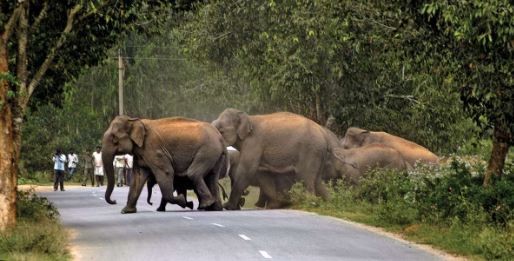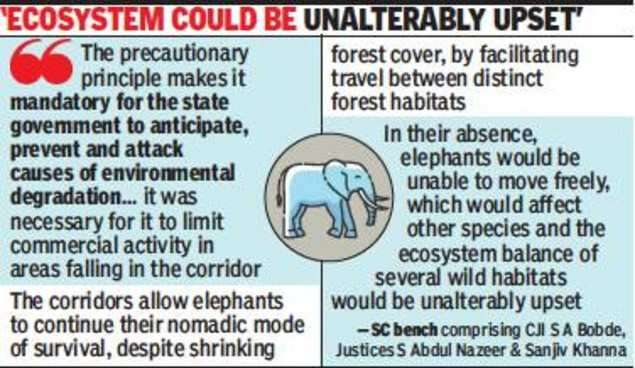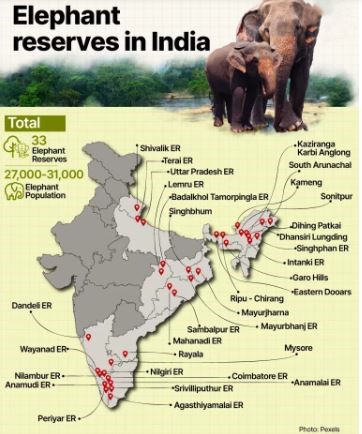Description

Disclaimer: Copyright infringement not intended.
Context
- The article “Efforts to reconnect elephant corridors must be carefully planned” highlights issues of elephant corridor management in India
What is a corridor?
- Landscape ecology in the 1960s defined a corridor as an elongated stretch of land joining two reserves. The landscape was conceived as a patchwork of habitat “patches”, usually reserves, within a “landscape matrix” used by humans.
- A corridor would help animals cross the matrix in a relatively safe manner to go from one protected area to the next.
Elephant corridors
- Elephant corridors are a strip of land that enables elephant movement between two or more friendly habitats.
- The corridors are reported by respective state governments.
|
State Wise Distribution of corridors
|
●West Bengal leads with 26 corridors, constituting 17% of the total.
●East central India contributes 35% (52 corridors), while the North East region has 32% (48 corridors).
●Southern India has 21% (32 corridors), and northern India has the lowest with 12% (18 corridors).
|
|
Status of Corridor Use
|
●The Elephant corridor report released by the central government showed a 40% increase in elephant corridors across 15 elephant range states in India.
●19% of corridors (29) show a decrease in use, and 10 require restoration due to impairment.
|
|
Increase in Corridors
|
●Elephants have expanded their ranges in the Vidarbha region of Maharashtra and southern Maharashtra bordering Karnataka.
●Elephant corridors have increased in these areas.
●Elephants have also been seen in increased numbers in Madhya Pradesh and northern Andhra Pradesh.
|
Issues in governing the corridors
- “Right of Passage: Elephant Corridors of India” report (ROP) by the Wildlife Trust of India in 2005 and 2017 has noted two main issues in governing the elephant corridors:
- The lack of a working definition of corridors. A corridor seen or designed by humans may not hold for animals, because their sensory world and physiological requirements are entirely different from ours and they decide their movement based on many variables unknown to us.
- Expert identification of corridors is fraught with difficulties as experts know some parts better than others and thus do not have a synoptic view of larger landscapes, which leads to a bias.

Other issues are:
- Narrowing Passage Width: Only 22% of corridors were of a width of one to three kilometers in 2017, compared with 41% in 2005, pointing to how constricted corridors have become in the past 12 years.
- Human Encroachment of Corridors: 21.8% of corridors were free of human settlements in 2017 compared with 22.8% in 2005, and 45.5% had 1-3 settlements in 2017 compared with 42% in 2005.
- Land-use Along Corridors: In terms of land use, only 12.9% of the corridors were totally under forest cover in 2017 compared with 24% in 2005, and Two in every three elephant corridors in the country are now affected by agricultural activities.
|
Conservation Status of Asian Elephants
●Convention of the Migratory Species (CMS): Appendix I
●Wildlife (Protection) Act, 1972: Schedule I
International Union for Conservation of Nature (IUCN) Red List of threatened species:
●Asian Elephant: Endangered
●African Forest Elephant: Critically Endangered
●African Savanna Elephant: Endangered

|
Conclusion
- For comprehensive insights into the intricacies of elephant corridor conservation in India, resources such as “Elephant Corridors of India 2023” by the Ministry of Environment, Forest and Climate Change, and “Right of Passage” by the Wildlife Trust of India are recommended. It is urgent to develop a national framework based on recent scientific methods that use movement data to secure habitat connectivity and conservation of a key species.
Source: https://www.downtoearth.org.in/news/wildlife-biodiversity/efforts-to-reconnect-elephant-corridors-must-be-carefully-planned-95308
|
PRACTICE QUESTION
Q. There are many issues and challenges in managing the elephant corridors in India. Critically analyze with examples. (150 words)
|












